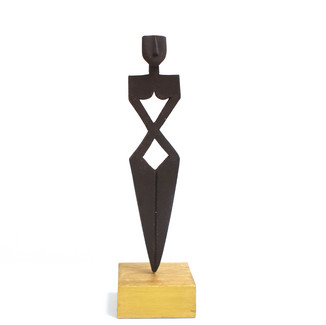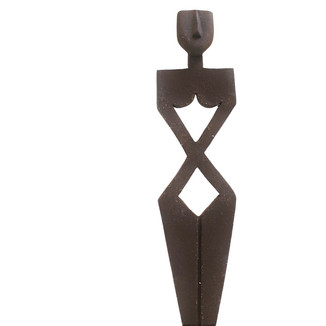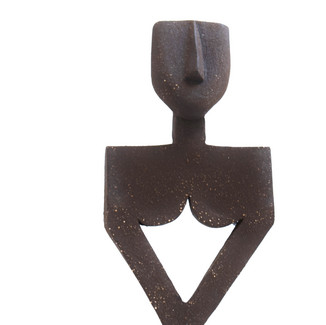Sculptor, traditional oil painter, author and researcher
You are working as an artist on a prehistoric sculpture series and have now completed the 4th series.
1. What inspires you to create these series?
I need to list several things that nurture my creative self.
When I was doing my master’s of science degree, I took some classes on anthropological studies from a Harvard scholar. These classes gave me a wide range of understanding about the psychic unity of humankind. Particularly the readings from Clifford Geertz about symbolic anthropology and from Evans-Pritchard about political anthropology had a huge impact on my way of interpreting the world.
When I was flirting with anthropological readings, I was also working for a big company, Nurol-Cengiz Joint Venture, as a full-time interpreter and translator. For their colossal construction, Ilisu Dam Project, I had to cooperate with some important names, such as Margarete van Ess from German Archaeological Institute and Klaus Nohlen from Hochschule RheinMain. Their profound knowledge enriched my ability to understand ancient civilisations. With this precious team, I had the chance to visit a number of archaeological sites in Upper Mesopotamia. Thanks to this unique experience, I was able to translate Ilisu Ethnography Report, a compilation of archaeological and ethnographic documents about tangible and intangible heritages. That’s how I became a big fan of ancient civilisations and decided to create my prehistoric sculpture series.
When I design a prehistoric sculpture, I temporarily go into their essence of worship. I assign a function to the design and plan anything related to it including its ceremonial introduction. Simply, I create new parallel beliefs where my designs have a ritualistic and, therefore, functional use. For example a sculpture, fictionally buried along with a maiden deceased, may serve as a guardian after death on the way to the Underworld. Or, a female figurine with protruding organs may serve as an amulet, fictionally containing the magic of fertility. I functionalise all aspects of a sculpture at the time of sketching.
As far as my inspiration for their form and shape is considered, I constantly watch anything around me. It may sound crazy but I was once inspired by a base station column, the entrance gate of a retailer, gills/cap pattern of a mushroom, and album cover of an unknown band in order to design an authentic sculpture. To this end, I do not skim through the museum catalogues or books over and over again to get inspiration, which is tricky and risky due to visual plagiarism reasons. Rather, I follow my own imagination and rely on my parallel beliefs to create authentic designs with a unique look.
2. How do you realise your ideas to the finished product?
My personal process of being mentally stimulated to create is a bit against the stream. I mean, it is definitely not unique or unprecedented but rare. It is extremely hard to put into words, but I suffer from a special condition, ASD (autistic spectrum disorder). In my life, it is both a reward and punishment for life. On one side, it significantly limits my social circles and leaves no nail on my fingers due to constant anxiety. On the other side, it gives me a high IQ, which ironically makes life unbearable to live with, and the ability paint realistically without any former art education or training and the capability to see patterns/things in chaos. It is more than synaesthesia (seeing shapes & colours in mind) or pareidolia/apophania (perceiving meaningful connections in an ambiguous visual pattern) only. To make it more understandable, I can refer to Beth Harmon’s ability in the Queen’s Gambit, the famous miniseries. Likewise, I can visualise (actually see in the literal sense) any design even at idea level. To do it, I need an environment as minimal and possible. For the sake of seeing my ideas concretely in my mind, I keep my living space simple and empty. To avoid any distraction, I do not use any curtain or any embroidered/decorative furniture/object at home. (Otherwise, my eyes and mind get tired accompanied by headache and tachycardia in the long run.) Similarly, there is no single artwork on my naked walls, although I am a traditional oil painter and sculptor. Simply nothing. In such convenient environments, I start designing just by gazing at empty walls or one-colour carpet on the floor. If it is a sculpture, I can switch its colours; (re)customise its limbs; turn it upside down or from left to right; and try possible/remote alternatives on it. I never say “Wait and see what will come out”. Both in sculpting and painting, I already see the result (finished version) right in the beginning. Surely it kills the excitement that most people enjoy to have in their projects. Unfortunately, I am not familiar with that feeling. Yet, no complaints.
I spent most of my time reading and thinking to create. I do not wait but spare time to do it. All the time, and wherever I go, I carry a piece of blank notebook and pencil with me. If I see any noteworthy connection or pattern in a chaos, I immediately take a note or draw a rough sketch so that I can remember it later (I have serious problem with short-term memory). After improving those ideas through more reasoning and thinking, I put them into final form. At the time of sculpting, I take this final form and baseline drawings as the reference point. I keep them in front of me (if on paper) while sculpting.
I have started to share my rough sketches and final products in my art catalogues so that people can make sense of my working routine.
3. In the 4th series you worked with Goerg & Schneider's potter's clay 366. How do you find the right quality for your series?
Yes, I used the clay body 366 by Goerg & Schneider for my 4th sculpture series. A lady, working for Ramfos Illikokeramiki in Athens, first recommended it for general use, but I used it for sculpting. I created more than seventy different sculptures using this unusual clay body. I call it unusual because it is very interesting. When it is fresh, it has a greenish black colour. However, when fired at 1100 Celsius degree, it turns dark chocolate colour and becomes more durable. It exactly looks and sounds like rusty iron.
To convince some people, I had to let them touch and feel my sculptures because no one ever believed that the designs looked and sounded like ceramics from a distance. If I do not inform them, they may continue assuming that they are casted sculptures.
Another point is the glittering granules (chammotte) in the clay body. I have used several types of clay bodies with high percentage of chammotte inside. However, I did not see the same effect on them. Honestly, those in the clay body 366 by Goerg & Schneider are amazing because they glitter like tiny stars in macro shoots under light. To make them more visible, I used a piece of sandpaper and rubbed it down. Those granules tend to stay on the surface and make a lovely texture. When fired, they become more visible.
Before kicking off my sculpture project, I tested the clay body 366 in my kiln and got satisfactory results. But my tests never ended there. I kept on testing the behaviour of this body at different temperatures and different positioning in the kiln. After finding the right positioning tricks (always on a flat surface), I never failed. Constant testing brings the right quality. This is what I believe in.






